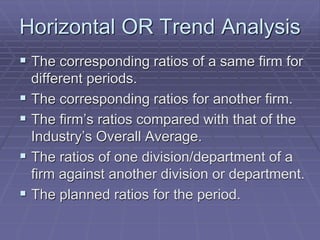This document discusses financial ratio analysis. It begins by outlining the six key principles of accounting: recording, classifying, summarizing, analyzing, interpreting, and reporting. It then discusses the five major categories of financial ratios - liquidity, asset management, debt management, profitability, and market value - and what key financial questions they aim to answer. The document provides examples of various ratios under each category, such as current ratio, debt-to-equity ratio, return on assets, and price-to-earnings ratio. It concludes by noting some limitations of ratio analysis, such as reliance on accurate financial data and accounting policies.

















![Liquidity OR Short-Term Solvency
Ratios
Net Working Capital =
Current Assets - Current Liabilities
Current Ratio = Current Assets
Current Liabilities
Acid Test/Liquid/Quick Ratio =
(Current Assets – Prepaid Expenses – Stock [Closing] – Loose Tools)
Current Liabilities](https://image.slidesharecdn.com/aqibfsanalysis-221102052812-d6888708/85/Financial-Statement-Analysis-18-320.jpg)

















